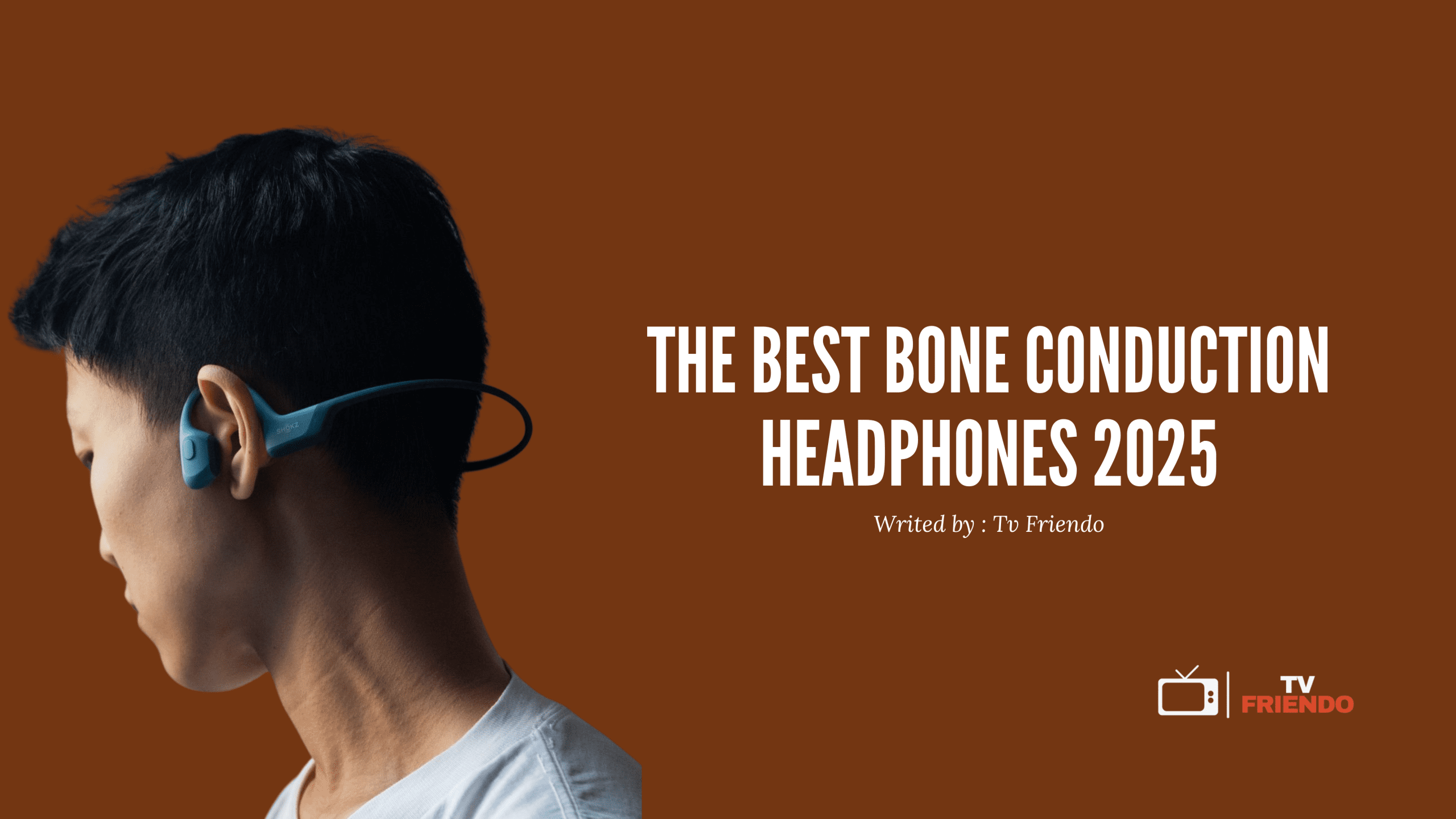The best bone conduction headphones 2025

Bone conduction headphones are revolutionizing how athletes and active people experience audio while staying safe. Particularly popular among runners, cyclists, and triathletes, these lightweight devices keep your ear canals open to environmental sounds while delivering clear audio. With Samsung reportedly entering this growing market later this year, we’re seeing more attention on this innovative technology than ever before.
As we explored the best bone conduction headphones available for 2025, we found impressive options for every activity. The Shokz OpenRun Pro 2, built on 10th-generation bone conduction technology, offers an exceptional 12-hour battery life for runners. Meanwhile, swimmers can benefit from the H2O Audio Tri 2 Pro Multi-Sport headphones with their IPX8 waterproof rating and 8GB of built-in storage. Additionally, the Shokz OpenSwim Pro provides up to 32GB of storage for phone-free listening during swims.
What makes bone conducting headphones truly stand out is their versatility across environments. From the Mojawa Run Plus with its IP68 rating for both running and swimming to the Suunto Wing’s innovative charging dock that adds three hours of battery life in just 10 minutes, these devices are designed for active lifestyles. Furthermore, they’re not just for athletes – bone conduction headphones can be particularly beneficial for individuals with hearing loss since they bypass the outer and middle ear completely.
In this guide, we’ll help you navigate the growing market of bone conduction earbuds and find the perfect pair for your specific needs and budget.
What Are Bone Conduction Headphones and How Do They Work?
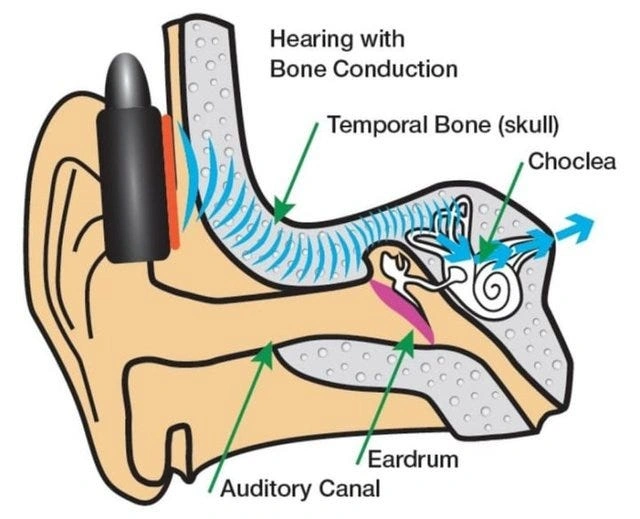
Unlike traditional headphones, bone conduction technology creates a unique pathway for sound to reach your ears. These innovative devices sit on your cheekbones, transmitting sound vibrations directly through your skull to your inner ear, bypassing your ear canal and eardrum completely.
Bone Conduction vs Air Conduction Explained
Most sounds we hear travel through air conduction—sound waves move through the air into our ear canal, causing our eardrum to vibrate. These vibrations transfer through three tiny bones in the middle ear (auditory ossicles) to the cochlea, where they’re converted into electrical signals for our brain to interpret as sound.
Bone conduction, however, takes an alternative route. When wearing bone conduction headphones like the Shokz OpenRun Pro, the transducers rest against your cheekbones or temples, creating vibrations that travel directly through your skull bones to your cochlea. This bypasses both the ear canal and eardrum entirely, yet your brain processes these vibrations identically to those received through traditional pathways.
Who Should Use Bone Conduction Headphones?
These specialized headphones are ideal for several distinct groups. Athletes and outdoor enthusiasts benefit tremendously from the open-ear design that maintains situational awareness—allowing runners and cyclists to hear approaching vehicles or other environmental sounds. Consequently, this safety feature has led England Athletics to permit only bone conduction headphones in road races where routes remain open to traffic.
Moreover, individuals who find traditional earbuds uncomfortable or poorly fitting will appreciate the external placement of bone conduction models. The Mojawa Run Plus and similar devices eliminate pressure points and irritation that can occur with in-ear options.
Benefits for People with Hearing Loss or Ear Canal Issues
For those with specific types of hearing impairments, bone conduction technology offers significant advantages. People with conductive hearing loss or middle ear pathologies can especially benefit, as these headphones bypass problematic areas of the hearing pathway altogether. In fact, this technology has its roots in hearing aid development, specifically bone-anchored hearing aids (BAHAs).
Additionally, bone conduction headphones are valuable for individuals prone to ear infections or excessive earwax buildup. By keeping the ear canal open and aerated, they reduce the risk of bacterial growth that can occur with traditional in-ear headphones, which often trap moisture and heat in the ear canal.
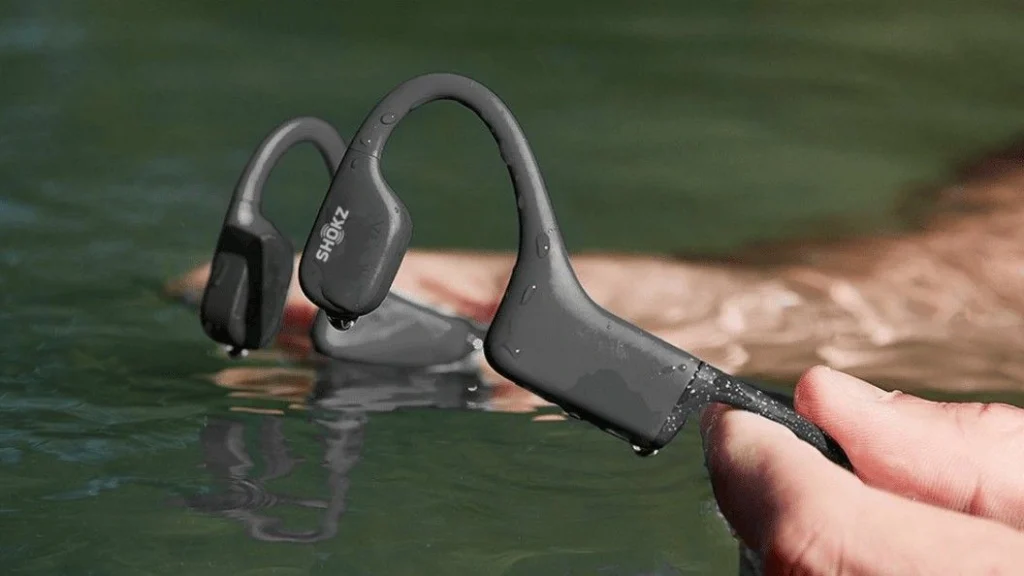
Different activities demand different features from bone conduction headphones. Today’s top models offer specialized capabilities that enhance performance across various scenarios.
For Runners: Shokz OpenRun Pro 2
Serious runners need headphones that deliver clear audio without sacrificing awareness. The Shokz OpenRun Pro 2 meets these demands with groundbreaking DualPitch™ Technology that pairs bone conduction for precise mids and highs with a dedicated air conduction speaker for powerful bass. This innovative design reduces vibrations while maintaining excellent sound quality. With an IP55 water-resistant rating, these headphones handle sweat and light rain effectively. Perhaps most impressive is the battery performance—up to 12 hours of music playback on a single charge, with a quick 5-minute charge providing 2.5 hours of listening time.
For Swimmers: H2O Audio Tri 2 and Shokz OpenSwim Pro
For aquatic enthusiasts, the H2O Audio TRI 2 offers exceptional versatility with its IPX8 waterproof rating, allowing submersion up to 12 feet for unlimited duration. Its 8GB storage holds thousands of songs in various formats. The Shokz OpenSwim Pro, therefore, presents an excellent alternative with 32GB storage—enough for approximately 8,000 regular quality songs. Both devices feature intuitive controls that work underwater and provide around 6 hours of battery life when using MP3 mode.
For Office Use: Shokz OpenComm UC
Office professionals will appreciate the Shokz OpenComm UC’s specialized features. The adjustable boom microphone with noise-canceling technology filters out 96.5% of background noise. Its lightweight design (36 grams) ensures comfort during long conference calls. With up to 16 hours of talk time and 8 hours of listening time, plus a 5-minute quick charge providing 2 hours of talk time, these headphones keep you connected throughout your workday.
For All-Round Use: Mojawa Run Plus
The Mojawa Run Plus excels as a versatile option with its IP68 waterproof rating, withstanding submersion up to 2 meters for 2 hours. Notably, it features 32GB of built-in storage alongside Bluetooth capabilities, allowing users to store approximately 8,000 songs. Its lightweight design (29g) and open-ear comfort make it suitable for various activities. The 8-hour battery life at 75% volume and 5-minute quick charge (providing 1.5 hours of playtime) ensure you’re rarely without audio.
Real-World Testing: Performance and Comfort Insights
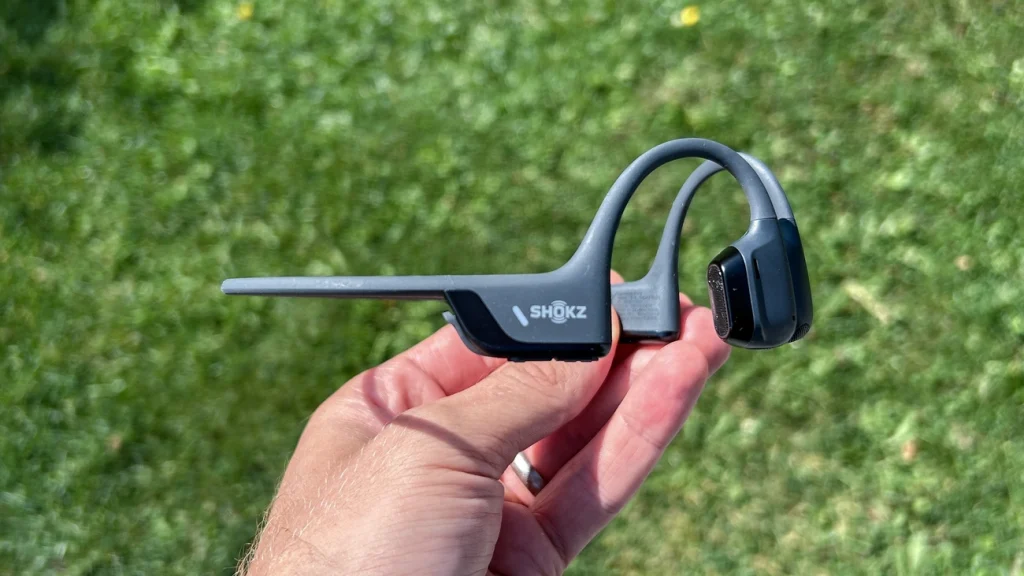
After extensive field testing across multiple scenarios, I found bone conduction headphones offer unique performance characteristics that traditional models can’t match. From acoustics to structural durability, these devices demonstrate distinct advantages and limitations worth exploring before purchase.
Sound Quality in Different Environments
The acoustics of bone conduction headphones vary dramatically with environmental conditions. In quiet settings like empty trails or home offices, sound clarity is impressive despite the open-ear design. Nevertheless, in noisy environments such as busy streets or gyms, ambient noise can easily overpower the audio, requiring higher volume levels that sometimes cause uncomfortable vibrations.
Sound leakage remains a persistent challenge with these devices. Even with recent improvements in models like the Shokz OpenRun Pro 2, nearby people can often hear audio at moderate to high volumes. For bass response, most bone conduction headphones traditionally struggle with low frequencies due to physical limitations of bone transmission. Accordingly, Shokz’s new DualPitch Technology assigns dedicated drivers for mids/highs and bass separately, significantly improving sound balance.
Fit and Comfort During Long Sessions
Weighing approximately 30 grams, premium bone conduction headphones like the OpenRun Pro 2 rest lightly on your temples rather than inside or on your ears. As a result, they eliminate the ear sweatiness and pressure common with traditional headphones. The latest models have reduced clamping force by sixteen percent through upgraded headband designs.
Throughout testing, I noticed these devices remain comfortable even after 3+ hours of continuous wear, though slight repositioning occasionally feels necessary. Essentially, the stability during vigorous activities is remarkable, with most models staying firmly in place during running, swimming, and cycling.
Battery Life in Daily Use
Real-world battery performance typically meets or exceeds manufacturer claims. The OpenRun Pro 2 delivers its promised 12 hours of continuous playback, whereas models like the Air and Titanium provide approximately 10 percent battery drain per hour of use. Notably, quick-charge capabilities have become standard—just 5 minutes of charging provides 2.5 hours of listening time on the OpenRun Pro 2.
Standby battery preservation is likewise impressive, with some units retaining 90 percent charge after a week without use.
Durability and Waterproofing in Action
IP ratings accurately reflect real-world durability. The Shokz OpenSwim with its IP68 rating genuinely withstands submersion up to 2 meters for 30 minutes. Nonetheless, following water exposure, thorough cleaning is essential as saltwater and chlorine can cause corrosion despite protective treatments.
Under daily use conditions, the titanium frames in premium models demonstrate excellent resilience against sweat, rain, and accidental drops. For swimmers specifically, waterproof models maintain clear sound underwater, though Bluetooth doesn’t function—requiring onboard storage for music during aquatic activities.
Choosing Between Models: Specs, Price, and Use Case Fit
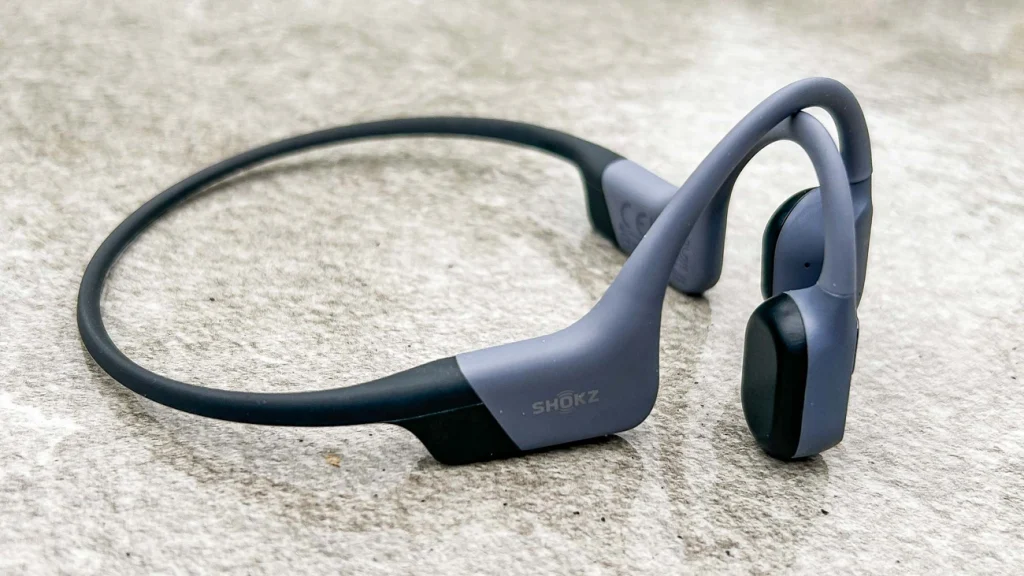
Selecting the ideal bone conduction headphones requires careful evaluation of technical specifications, budget considerations, and intended usage. Let’s examine how today’s top models compare across critical metrics.
Comparison Table: Battery, IP Rating, Storage
When comparing bone conduction headphones, three specifications stand out as particularly important:
| Model | Battery Life | IP Rating | Storage | Weight |
|---|---|---|---|---|
| Shokz OpenRun Pro 2 | 12 hours | IP55 (sweatproof) | None | 30g |
| Shokz OpenSwim Pro | 9 hrs (6 hrs MP3) | IP68 (waterproof) | 32GB | 27g |
| H2O Audio Tri 2 | 9 hrs (6 hrs MP3) | IPX8 (waterproof) | 8GB | 32g |
| Mojawa Run Plus | 8 hours | IP68 (waterproof) | 32GB | 29g |
| Shokz OpenComm UC | 16 hrs talk, 8 hrs listen | IP55 (sweatproof) | None | 35g |
| YouthWhisper Lite | 6 hours | IP65 (water-resistant) | None | 25g |
Price Breakdown: Budget to Premium
Bone conduction headphones typically fall into three price categories:
Budget ($30-50): Models like YouthWhisper Lite and Tayogo offer basic functionality with decent battery life and water resistance. They’re perfect for trying the technology without major investment.
Mid-Tier ($75-130): The sweet spot includes models like Shokz OpenRun ($130) with IP67 waterproofing and 8-hour battery life. You’ll find USB-C charging and noise-canceling for calls in this range.
Premium ($130-200): Flagship models including Shokz OpenRun Pro 2 ($160) feature maximum battery life, advanced Bluetooth connectivity, and proprietary technologies for enhanced sound quality.
Which Model Is Right for You?
Initially consider your primary activity. For running, the Shokz OpenRun Pro 2 offers superior battery life coupled with sweatproofing. Swimmers should prioritize waterproof ratings of IP68 or IPX8, with models like H2O Audio Tri 2 or Shokz OpenSwim Pro providing essential storage for underwater use.
For daily office use, first and foremost look at microphone quality and battery longevity, making the Shokz OpenComm UC with its 16-hour talk time ideal.
If budget constraints exist, mid-tier options provide excellent value. In essence, prioritize IP ratings (minimum IP55 for sweaty workouts, IP68 for swimming), battery life (at least 8 hours for most activities), and comfort features according to your specific needs.
Conclusion
Bone conduction headphones certainly represent a remarkable evolution in audio technology, particularly for active individuals. Throughout my testing, I found these devices offer unparalleled situational awareness while delivering surprisingly good sound quality. Furthermore, their unique transmission method provides accessibility benefits that traditional headphones simply cannot match.
Safety remains the most compelling reason to consider these specialized headphones. The ability to hear environmental sounds clearly while enjoying music or podcasts proves invaluable for runners and cyclists navigating busy streets. Additionally, their lightweight design and secure fit make them ideal companions for everything from marathon training to lap swimming.
Speaking of swimming, waterproof models like the H2O Audio Tri 2 Pro and Shokz OpenSwim Pro deserve special attention. Their built-in storage eliminates the need for waterproof phone cases or specialized mp3 players. Likewise, the Mojawa Run Plus offers exceptional versatility with its comprehensive waterproofing and substantial storage capacity.
Accessories can further enhance your bone conduction experience. Aftermarket silicone covers provide additional grip during intense workouts, while specialized carrying cases protect your investment. Some users also pair bone conduction headphones with earplugs for noisy environments – this combination maintains awareness while blocking unwanted ambient noise.
Price points have become increasingly reasonable as the technology matures. Though premium models command higher prices, budget-friendly options like the YouthWhisper Lite deliver impressive performance without breaking the bank. Most importantly, nearly all models now feature quick-charging capabilities that align perfectly with active lifestyles.
The future looks bright for bone conduction technology. Rumored entries from major manufacturers like Samsung will undoubtedly drive further innovation. Nevertheless, current offerings already deliver exceptional performance for their intended use cases. Whether you’re a dedicated athlete, office professional, or someone with specific hearing needs, bone conduction headphones provide a unique listening experience that balances awareness with audio enjoyment – a combination traditional headphones simply cannot achieve.
FAQs
Q1. What are the advantages of bone conduction headphones? Bone conduction headphones offer situational awareness by keeping your ears open, making them ideal for outdoor activities. They’re also beneficial for people with certain types of hearing loss and those who find traditional earbuds uncomfortable.
Q2. How do bone conduction headphones compare to traditional headphones in terms of sound quality? While bone conduction headphones have improved, they typically don’t match the bass response and overall sound quality of traditional headphones. However, they excel in providing clear audio while maintaining awareness of your surroundings.
Q3. Are bone conduction headphones suitable for swimming? Yes, some models like the H2O Audio Tri 2 and Shokz OpenSwim Pro are specifically designed for swimming. They offer waterproof ratings up to IPX8 and include built-in storage for underwater listening without Bluetooth connectivity.
Q4. How long do bone conduction headphones typically last on a single charge? Battery life varies by model, but many high-quality bone conduction headphones offer 8-12 hours of playback time. Some models, like the Shokz OpenRun Pro 2, provide up to 12 hours of continuous use on a single charge.
Q5. Can bone conduction headphones be used for phone calls? Yes, many bone conduction headphones include built-in microphones for taking calls. Some models, like the Shokz OpenComm UC, are specifically designed for office use with noise-canceling microphones and extended talk time battery life.

